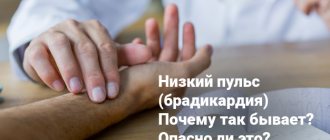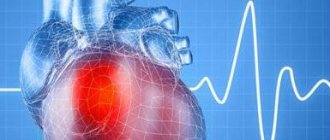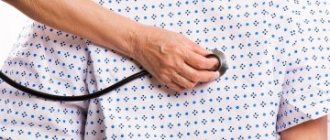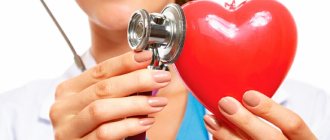Causes
So, bradycardia in children is a decrease in heart rate from 5 to 40% below normal. The complex formulation is explained by two phenomena. Firstly, a child’s heart beats much faster than an adult’s. Secondly, each age has its own normal heart rate.
Even when the baby is in the womb, the fetal heart rate changes at different stages of pregnancy.
Before the heart contracts, a nerve impulse first originates in the sinus node, which is located in the right atrium. Then the excitation wave propagates through the conduction system to the ventricles. When it reaches them, the myocardium contracts and blood is released into the vessels.
Bradycardia can develop as a result of a slowdown in the formation of nerve impulses or an increase in the time they take to travel through the conduction system of the heart.
This can happen due to the following reasons:
- heart diseases - myocarditis, congenital defects (atrial or ventricular septal defects, arrhythmogenic right ventricular dysplasia, etc.);
- diseases of the endocrine system - the most prominent representative is hypothyroidism (decreased synthesis of thyroid hormones);
- high concentration of potassium in the blood - this can happen, for example, in severe diseases accompanied by renal failure;
- infections – typhoid fever, brucellosis, mumps;
- overdose of certain medications;
- congenital anomalies of the cardiac conduction system.
Bradycardia in the fetus during pregnancy can occur both as a result of developmental defects (for example, heart defects) and as a result of maternal diseases - severe anemia, thrombosis, systemic vasculitis, etc.
There is a phenomenon called “benign bradycardia-asystole in the fetus.” It usually develops in the second trimester of pregnancy. These are short episodes (just a few seconds) of bradycardia and complete cardiac arrest. They are temporary and absolutely safe for the health and life of the child.
Bradycardia in newborns usually indicates a serious condition of the baby (for example, prematurity) and requires urgent resuscitation measures.
Sinus bradycardia: causes, dangers and treatment
Sinus bradycardia is a violation of the heart rate, expressed in its slowing down to less than 60 beats per minute. It can be either a variant of the norm or indicate pathology. The physiological form is often observed in athletes; the norm is a slow heartbeat in sleeping people.
Risk factors, types
Physiological bradycardia indicates that in humans the inhibitory effect of the nervous system on the activity of the heart predominates.
Physiological sinus bradycardia does not cause concern in the following cases:
- heart rate of at least 50 beats per minute;
- no complaints from the patient;
- The rhythm is not disturbed (the same time intervals between beats).
Pathological form
Pathology includes a slowing of the heart rate in the following cases:
- absence of prerequisites (there are no factors that could lead to bradycardia);
- manifestation of bradycardia with sudden attacks;
- arrhythmic pulse;
- There are complaints about poor general health.
8
24/7
Causes
Sinus bradycardia is not a disease in itself. This is a symptom that may accompany the development of other diseases. These include:
- vegetative-vascular dystonia;
- acute and chronic forms of heart disease (these are myocarditis, heart attacks, cardiomyopathies, weakness of the sinus node);
- brain lesions (TBI, meningitis, tumors, meningoencephalitis);
- excessive drinking, smoking, drug use;
- intoxication with chemicals, work in hazardous industries;
- severe infections (associated with damage to any organ - intestinal infections, pneumonia, abscesses);
- cancerous tumors of the neck and chest area;
- the use of medications that slow down the heart rate (asparkam, verapamil, etc.);
- diseases of the endocrine system (adrenal insufficiency, hypofunction of the thyroid gland, manifested by hypothyroidism);
- severe liver and kidney diseases.
Symptoms
The severity of clinical manifestations is directly related to how many beats the pulse becomes slower.
With a heart rate in the range of 50 - 60 beats, the clinical picture looks like this:
- complaints about the general condition – dizziness, weakness are practically absent;
- consciousness and breathing remain normal;
- blood pressure does not change.
Thus, in this case, only a slow pulse will indicate bradycardia.
With a pulse between 30 and 40, the symptoms are as follows:
- there are complaints of general malaise, dizziness, headache and chest pain, shortness of breath;
- changes in consciousness are observed, which are manifested by drowsiness, lethargy;
- blood pressure decreases;
- the pulse not only slows down, but also becomes weak;
- breathing quickens, shortness of breath appears.
When the pulse is 30-39 beats, severe sinus bradycardia occurs:
- the complaints listed in the paragraph above become pronounced, the patient is forced to remain in a supine position;
- general condition – critical;
- disturbances of consciousness are manifested by coma, i.e. consciousness is absent;
- blood pressure is greatly reduced;
- pulse is not detected;
- shallow breathing (may be absent).
Sinus bradycardia can manifest itself in different ways: be paroxysmal or chronic. The attack can last several minutes, hours, days. The chronic form is more favorable from the point of view of prognosis, especially if the deceleration is small - from 50 to 60 beats. In such cases, the body can readjust and adapt to the slower rhythm.
Sudden attacks are very dangerous, especially if the slowing of the heartbeat was preceded by tachycardia.
8
24/7
Diagnostics
The primary diagnosis can be made based on the patient's complaints and examination. It can be reliably confirmed or excluded by performing an ECG.
Sinus bradycardia on the cardiogram will be reflected by an increase in the intervals between the ventricular complexes and the correct sinus rhythm.
With this diagnosis, the cardiogram is almost identical to normal, with the exception of rarer contractions. If at the time of the cardiogram it was not possible to register an episode of bradycardia, then a Holter study should be performed. This procedure involves the patient wearing a special device during the day, which automatically takes and records all the necessary indicators.
Ultrasound is used to detect lesions of the organic nature of the heart.
Laboratory tests may also be performed. They include analysis of the electrolyte composition of the blood, analysis of hormones, determination of toxins, as well as bacteriological analysis if infectious causes of palpitations are suspected.
Treatment
If physiological sinus bradycardia occurs, no treatment is required.
Indications for treatment are:
- dyspnea;
- fainting;
- general weakness;
- hypotension;
- heart rate drops to 40 beats/min.
Sinus bradycardia requires outpatient treatment, but in severe cases the patient may be hospitalized.
Drug treatment
How to treat sinus bradycardia if it is not physiological?
For bradycardia, it is necessary to take drugs that stimulate contractions and also neutralize the effect of the autonomic nervous system on the conduction pathways. Such medicines include:
- Anticholinergics. Atropine - inhibits the activity of the parasympathetic nervous system, thereby accelerating the heart rate. The drug is intended for injection and can be used subcutaneously or intravenously. It is characterized by a number of side effects, so it is not suitable as a drug for regular use, but it is effective as an emergency aid.
- Adrenergic agonists. Isoprenaline – intended for oral or intravenous use. This is an analogue of adrenaline, simulating the sympathetic department of the autonomic nervous system and activates the functioning of the heart receptors.
- Eufillin. This is a bronchodilator, but it is also indicated when it is necessary to increase the pulse rate. Admission is carried out by intravenous infusion.
It is advisable to take these medications during the period of recovery of the heart rate; when the indicator is brought to normal, they are canceled.
It is also possible to use herbal medicine. Eleutherococcus and ginseng will help increase heart rate and raise blood pressure.
In the chronic form of sinus bradycardia, it is necessary to use drugs aimed at activating metabolic processes. This:
- antioxidants and cardioprotectors (antioxycaps, omega-3);
- drugs that stimulate metabolism in cardiomyocytes (mildronate);
- nootropics (piracetam);
- vitamin complexes.
Complex forms of bradycardia, accompanied by loss of consciousness and developing against the background of lesions of an organic nature, are eliminated through surgical intervention. In such cases, a pacemaker is installed.
Emergency help
Emergency assistance is necessary when the patient experiences a deterioration in their general condition due to a decrease in heart rate of less than 50 beats per minute.
It is necessary to place the patient on his back and provide access to oxygen.
After this, you should check for consciousness and breathing. If they are absent, cardiac massage and artificial respiration are performed.
The following medications can be used:
- Zelenin drops. Used for oral administration in all cases of bradycardia while maintaining consciousness.
- Atropine sulfate. It is administered by injection - subcutaneously or intravenously when the heart rate decreases below 50 beats per minute.
- Dopamine. Taken when heart rate drops below 50 beats per minute with a drop in blood pressure.
- Adrenalin. Administered intravenously or subcutaneously for cardiac arrest (heart rate less than 30 beats per minute).
Forecast
Elimination of symptoms of sinus bradycardia is observed in 95% of cases.
In almost all patients (90-95%), drug treatment is sufficient.
5-10% of cases require implantation of a pacemaker. This procedure restores normal rhythm in all cases immediately after the intervention.
If treatment is not started when a problem is detected, complications may develop. Negative consequences include worsening manifestations of ischemia, myocardial infarction, stroke, heart failure, and cardiac arrest.
Prevention
First of all, preventive measures should include a healthy lifestyle. This includes giving up drinking alcohol, smoking, and controlling your diet. You will need to exclude sweets and fatty foods from the menu. It is necessary to play sports, but it is recommended to discuss the amount of permissible physical activity with your doctor.
Any diseases must be eliminated immediately after detection to prevent them from becoming chronic.
Medicines may only be taken as prescribed by a specialist. You should not try to eliminate the symptom yourself.
If alarming symptoms occur, you should immediately consult a doctor, undergo examinations and begin heart treatment if pathology is detected.
If there are any abnormalities in the functioning of the heart, it is imperative to undergo preventive examinations. And the sooner the patient signs up for a consultation, the better.
8
24/7
Signs and symptoms
The clinical picture directly depends on the degree of bradycardia. With a slight slowdown in heart rate, the child can feel great without experiencing any discomfort.
With a more pronounced decrease in heart rate, the child becomes less energetic, he gets tired quickly, he is constantly sleepy, and his skin becomes pale. His head is spinning and his vision is getting dark. He may even faint.
Sometimes I had to observe children who, due to severe bradycardia, lost consciousness, their heart stopped beating for a while and their breathing stopped, then convulsions began. After a few seconds or a couple of minutes, the child comes to his senses. This resembles an epileptic seizure. This phenomenon is called Morgagni-Adams-Stokes syndrome. It develops when the heartbeat is very slow. Its occurrence is due to severe hypoxia (oxygen starvation) of the brain.
An attack of Morgagni-Adams-Stokes syndrome is a very dangerous condition, as it can lead to the rapid death of a child.
In what cases should you immediately consult a doctor?
If your child does not exercise seriously and his heart rate is lower than normal for his age, he should be seen by a cardiologist, but not necessarily right away. It’s another matter if he is lethargic, sleepy all the time, and faints. In this case, a visit to the doctor should not be postponed. And finally, if a child develops an attack of Morgagni-Adams-Stokes syndrome, you need to call an ambulance.
Moderate sinus arrhythmia in a child
Moderate sinus arrhythmia in a child is not dangerous if its cause is immaturity of nervous regulation, as is the case with respiratory arrhythmia. However, even trained children may experience seemingly causeless sinus arrhythmia, and in this case, a visit to a cardiologist is mandatory. Each case of arrhythmia in a child must be subjected to observation and strict control, because if sinus arrhythmia occurs without an obvious reason, especially if the child makes complaints, which will be discussed below, a comprehensive examination of the body is necessary.
Regular observation by a cardiologist is the key to timely diagnosis of the transition of a moderate arrhythmia in a child into something more serious. Often respiratory arrhythmia is detected during a routine examination, but sometimes the child makes specific complaints. If the child’s age is too young for him to be able to formulate a complaint about poor health or pain, sufficiently observant parents themselves can notice changes in the child’s behavior if they look closely at the baby. When the heart stops working, the child may experience cyanosis (blue discoloration) or pale skin.
This is also accompanied by shortness of breath, which may manifest itself at a younger age as intermittent, “choking” crying. Such cases of arrhythmia can appear at any time of the day, and therefore the child is characterized not only by anxiety during the day, but also by sleep disturbance at night. The baby loses his appetite or continues to eat, but with great reluctance. Also, if you look closely, in some cases you can see the pulsation of large vessels. Older children may lose consciousness when a cardiac arrhythmia occurs or complain of dizziness. Also at this moment, the pressure may decrease, and some children feel the heart skip a beat or, conversely, make a strong push.
Of course, each of the listed complaints in itself seems to be a reason for a visit to the doctor, and if there is a combination of several of them, most likely the child suffers from something more serious than mild sinus arrhythmia. First of all, after the examination, the child will be sent for electrocardiography, and then two scenarios are possible: the baby can continue to be monitored on an outpatient basis or be sent to hospitalization. In case of hospitalization, tests include a clinical blood and urine test, an ultrasound examination of the heart, an echocardiogram, and a chest x-ray. In general, each diagnostic case is individual, and further tactics are determined by the attending physician.
What bradycardias are most common in children?
Depending on the mechanism of development (slowing the formation or conduction of a nerve impulse), as well as on electrocardiographic signs, the following types of bradyarrhythmia in children are distinguished:
- sinus;
- atrioventricular (atrioventricular) blockades of II and III degrees;
- intraventricular blockades (bundle branch blocks);
- sick sinus syndrome.
There are also intraatrial blocks, but they are rarely accompanied by a slow heartbeat. You can find out more about what it is and how to act correctly here.
Attacks of Morgagni-Adams-Stokes syndrome occur with atrioventricular blockade and sick sinus syndrome
The most common of all forms is sinus bradycardia.
Sinus bradyarrhythmia
Unlike other types, with sinus bradycardia the heartbeat is slow but rhythmic. It poses the least danger to the health and life of the child, i.e. is the most benign of arrhythmias,
I also want to note that sinus bradycardia is not always a pathology. For example, sinus bradyarrhythmia in a child can be observed during sleep. Children who play sports intensively and regularly perform intense physical exercise also often experience a similar phenomenon, which is the absolute norm. The issue of heart rate slowing in athletes is well discussed here.
Types of bradycardia
At the first examination, a pediatric cardiologist in Saratov will help determine the main type of bradycardia in order to prescribe treatment and supportive procedures in the future. It is customary to distinguish the following types:
- Physiological - especially popular among athletes and does not harm the body. It is often called moderate bradycardia because it is caused by a well-trained heart.
- Absolute - an anomaly in which violations are observed under various circumstances.
- Relative - diagnosed in children under certain stable factors: crying, fever, sports or emotional stress.
Bradycardia in children is often caused by congenital heart disease. The main threat is that if the working rhythm is disrupted, the heart does not pump the required amount of blood, which means that the required amount of oxygen does not reach the brain. Pediatric cardiology in Saratov will select the most effective and supportive therapy for your health. The child will be less tired, will be able to do more physical exercise, and over time may even learn suitable sports.
What tests should your child undergo and when?
As the first method of examination, I prescribe electrocardiography. This allows you to determine the type of bradycardia.
ECG signs of sinus bradycardia:
- a decrease in heart rate in the form of an increase in the distance between the R waves;
- correct sinus rhythm - the same distance between the R waves and the presence of positive P waves that have a normal shape in leads II, III and aVF.
ECG signs of atrioventricular block:
- II degree – increase in the PQ interval, periodic loss of the QRS complex;
- III degree – complete inconsistency of atrial and ventricular rhythms, i.e. different number of P waves and QRS complexes.
ECG signs of sick sinus syndrome:
- a decrease in heart rate in the form of an increase in the distance between the R waves;
- attacks of paroxysmal supraventricular tachycardia and atrial fibrillation may occur.
Sometimes bradyarrhythmias can occur in attacks. Therefore, I additionally prescribe Holter (24-hour) ECG monitoring. I also perform echocardiography if a congenital heart defect is suspected.
If, based on the cardiogram data, I suspect that the child has sick sinus syndrome, then to confirm it, I prescribe an electrophysiological study of the heart.
Treatment
Not all bradycardia requires special treatment. If the decrease in heart rate is insignificant and is not accompanied by any clinical symptoms, therapy is not needed.
The type of bradyarrhythmia also matters. If your child has significant sinus bradycardia (below 25-40% of normal for age) and does not exercise, the first step is to evaluate him for a possible cause of the slow heart rate. This involves checking the blood concentration of thyroid hormones, potassium, measuring intracranial pressure, etc.
Often, eliminating the causative factors is quite enough to normalize the heartbeat.
Unfortunately, there is no effective medicine for the permanent treatment of bradyarrhythmia. To improve the child’s condition only briefly, I use the following drugs - anticholinergics (Atropine) and beta-adrenergic agonists (Isadrin). They allow you to increase your heart rate for a short time.
The most effective treatment for severe bradycardia today is pacing - temporary or permanent.
Temporary pacemaker involves delivering a weak electrical current through the skin of the chest or through the esophagus. In most cases, this allows for normalization of heart rate. Transesophageal stimulation is especially effective for relieving bradycardia in infants and children under 2 years of age.
If it is unsuccessful, then a permanent pacemaker is installed. This is a small device that ensures a normal heart rate. It is sewn under the skin in the subclavian area. Wires from it go through large vessels directly to the heart.
Expert advice
If your child suffers from any cardiac disease and is prescribed drugs such as beta-blockers (Bisoprolol, Metoprolol) and calcium channel blockers (Verapamil, Diltiazem) for treatment, you need to remember that the pulse may slow down while taking them. A decrease in heart rate by approximately 5-10 beats from the lower limit of the age norm is not dangerous. But, if the child’s heart rate decreases more, the cardiologist must be informed about this so that he can adjust the dosage.
Case from practice
I will give an example from my own experience.
A mother and her 14-year-old child came to see me. Recently, the mother noticed that her daughter became slow, sleepy and lethargic, and began to gain weight, despite her poor appetite. When I began to examine the girl, I discovered a decrease in heart rate to 52 beats per minute, swelling of the face, legs and arms, and an enlargement of the thyroid gland. I ordered an electrocardiogram, an analysis of thyroid hormones, antibodies and an ultrasound examination of the thyroid gland. The results showed sinus bradycardia, increased levels of TSH and thyroglobulin antibodies, and decreased free thyroxine (T4). The diagnosis was made: “Autoimmune thyroiditis (Hashimoto’s), stage of hypothyroidism.” Hormone replacement therapy with L-thyroxine was prescribed. Some time after the start of treatment, the girl became more energetic, swelling disappeared, and her weight and heart rate returned to normal. Recommendations are given to regularly donate blood for thyroid hormones to monitor the effectiveness of therapy.
How dangerous is the disease?
More severe complications occur with severe forms of the disease. The child’s body constantly experiences a lack of oxygen, the blood supply to soft tissues deteriorates, and the elimination of toxins and decay products slows down. This leads to the death of heart tissue and nerve fibers, and concomitant diseases of the kidneys, liver, and thyroid gland develop.
Among the dangerous complications:
- fainting;
- brain hypoxia;
- heart failure;
- thrombosis;
- increased risk of ischemic stroke;
- tachycardia.
In the absence of treatment or ignoring the recommendations of doctors, the child develops cardiopathy or angina pectoris, requiring surgical intervention.










